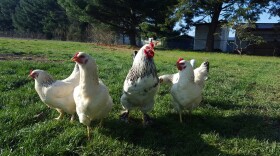A highly contagious avian flu strain was recently detected in a backyard flock of 15 chickens in Franklin County. That’s according to the Ohio Department of Agriculture, which helped confirm the virus in collaboration with the U.S. Department of Agriculture.
The H5N1 avian flu strain has been spreading throughout the Midwest in recent months. It was first detected in early 2022. It’s currently been detected at nearly 100 sites across 21 states on the eastern half of the U.S., according to the USDA.
The virus can infect poultry such as chicken, turkeys, quail or domestic ducks and can be fatal. It’s typically spread by migratory patterns of waterfowls such as ducks and geese.
As the wild birds fly across U.S. states, they might be carrying the virus and spreading it through their droppings, according to Dennis Summers, the state veterinarian with the Ohio Department of Agriculture.
Avian flu strains aren’t new, the last major outbreak, which was also the country's largest, happened between 2014 and 2015. More than 50 million poultry birds were impacted. It was a similar strain to the H5N1.
Summers said it’s concerning when viruses like these spread to commercial poultry barns, which can be devastating to farmers and supply chains.
“It can spread relatively quickly,” Summers said. “If we can't control the spread of the virus within the commercial industry, it affects everything from potentially the price of your eggs and poultry products at the supermarket to international trade.”
Summers added state authorities take aggressive measures to mitigate the spread, typically by depopulating barns with infected poultry.
Although the virus can be fatal to birds, the virus is of low risk to humans, according to the Centers for Disease Control and Prevention. Some rare cases of human illnesses have been reported, but the CDC indicates it’s typically from prolonged exposure to sick or dying poultry.
“Luckily right now, there's no indication that this current strain poses any significant risk to human health populations, at least here in the U.S. That risk is still considerably low,” Summers said.
For backyard chickens or turkeys, state and federal agencies recommend the birds be brought indoors in a coop or other enclosure, keep visitors to a minimum and to avoid contact with wild birds.
Summers said backyard birds with symptoms such as loss of appetite, decreased egg production, swelling or even an unusual number of dead birds, warrants a call to state authorities, which can then have the birds tested.
“We worry about avian influenza every single year just because of the nature of the virus itself,” Summers said. “If you have poultry and notice signs of sickness or death, contact your departments of agriculture. We are here to help.”
Alejandro Figueroa is a corps member with Report for America, a national service program that places journalists into local newsrooms. Support for WYSO's reporting on food and food insecurity in the Miami Valley comes from the CareSource Foundation.
Copyright 2022 WYSO. To see more, visit WYSO.




